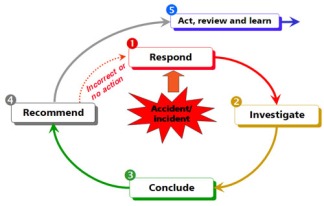
OSHA guidelines can help employers implement and maintain a successful safety program throughout their organization.
Implementing a quality safety program is essential to reducing workplace accidents. To assist in building this program, OSHA provides you with all the guidance you need to get started.
OSHA doesn’t officially require employers to develop comprehensive safety and health programs, but doing so is an effective way to ensure you stay in compliance with OSHA standards. More importantly, it is the cornerstone of building a comprehensive safety culture, which is the best way to reduce work-related injury and illness as well as their associated costs.
If you currently have a weak or nonexistent safety program, following OSHA’s suggestions can help simplify the process while you begin integrating a focus on safety into your everyday operations.
Based on its Safety and Health Program Management Guidelines, OSHA has outlined four basic elements of a successful safety and health management program.
Management Leadership and Employee Involvement
OSHA recommends that the highest levels of management commit the necessary resources of staff, money and time to ensure that everyone on the worksite is protected from injury and illness hazards. Without the continued support of management there is no way a safety program will get off the ground. Specifically, OSHA recommends annual review, goal setting and action planning at all levels of management, with input from employees across the spectrum of the organization.
Worksite Analysis
OSHA’s sample plan recommends that all employers conduct a baseline survey to identify all safety and health hazards at the site at the time of implementation and control or eliminate (when possible) all hazards found. Reviewing employee injury records can also be valuable as they may identify a common cause.
Depending on the industry, you may be able to assess risks on your own. If you have any doubts about possible hazards, it is recommended that you call in an outside expert or consultant to review your operations and provide possible solutions.
In addition to identifying existing hazards so they can be dealt with, a worksite analysis will denote the conditions at the start of your program, establishing a baseline that will allow you to measure improvement. This will help you track development and allow you to benchmark your processes against others in your industry. Periodic review of your programs effectiveness, along with ongoing monitoring of employee injuries, is needed for your safety program’s continued success.
Hazard Prevention and Control
All hazards discovered during the Worksite Analysis should be eliminated if possible. Alternate control methods should be used for those hazards that remain. This may include engineering or administrative controls or the use of personal protective equipment.
It is also recommended that you determine which OSHA standards apply to the work being conducted so individual safety and health programs can be established for each.
Training
OSHA recommends that all employees receive sufficient training to understand what their individual safety and health responsibilities are, and how to fulfill them. Supervisors should personally provide each employee with safety materials and guidance pertaining to his or her job. These measures might include:
– Making sure that each employee has access to a safety manual for review and future reference.
– When applicable, delivering a personal copy of safety rules, policies and procedures pertaining to specific employees’ duties.
– Asking questions of employees, and answering employees’ questions, to ensure knowledge and understanding of safety rules, polices and job-specific procedures described in the safety program manual.
– Training each new employee – through verbal instruction and demonstration – on how to perform assigned job tasks safely.
– Observing employees performing the work and making sure they are doing it safely. If they are not, the supervisor should provide additional training before permitting the employee to do the work without supervision.
– Providing all employees with safe operating instructions on seldom-used or new equipment before using the equipment.
– Reviewing safe work practices with employees before permitting the performance of new, non-routine or specialized procedures.
– Communicating accident reporting procedures and the importance they have for the continued success of the program as a whole.
Refresher training should occur periodically to keep standards high. If work environments or job tasks change, employees should receive updated instruction.
Creating an effective safety program for your organization based on OSHA’s Four-Point Program is a great first-step in reducing your organization’s workers’ compensation costs. This program, coupled with ongoing safety initiatives and program benchmarking, can mean thousands of dollars saved in premiums, increased productivity and reduced claims costs.








 According to the Occupational Safety and Health Administration (OSHA), one of the most effective ways to promote a safe working environment is to get involved in company safety meetings. Since safety is our top priority, we’ve gathered some tips to help you make the most out of our company safety meetings.
According to the Occupational Safety and Health Administration (OSHA), one of the most effective ways to promote a safe working environment is to get involved in company safety meetings. Since safety is our top priority, we’ve gathered some tips to help you make the most out of our company safety meetings.
